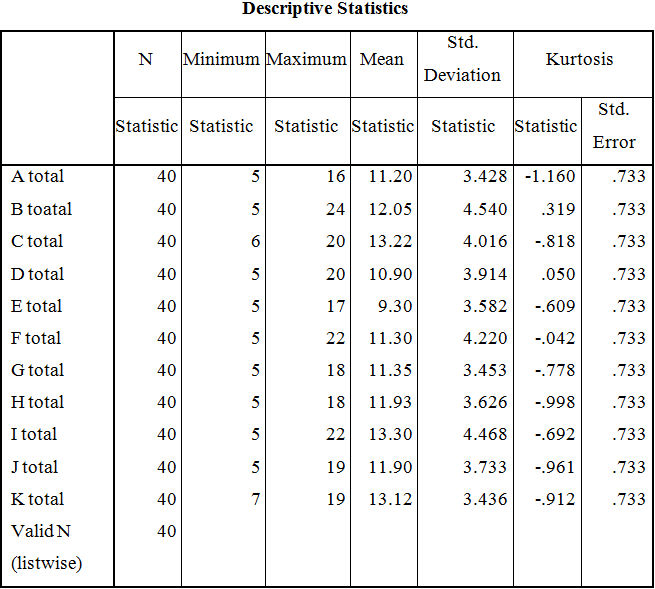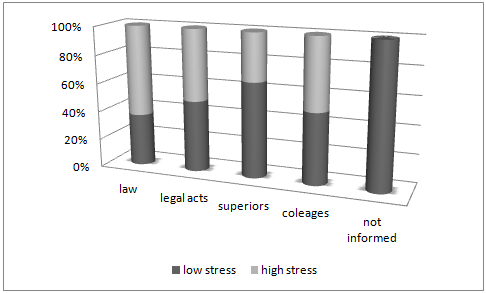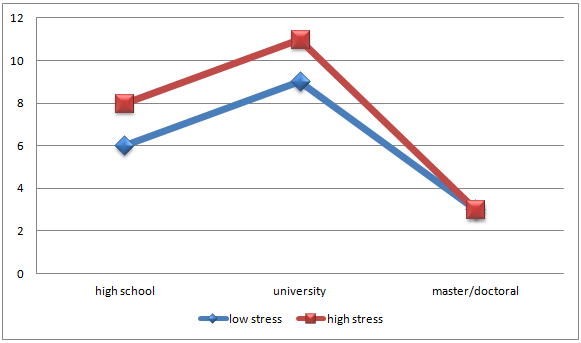ДОМИНИРУЮЩИЕ КАТЕГОРИИ СТРЕССА НА РАБОЧЕМ МЕСТЕ В УЧРЕЖДЕНИЯХ МАКЕДОНИИ
Ильевский А.1, Угриновска Е.2 1Профессор, доктор юридических наук, Международный Славянский Университет им Державина, 2Магистрант, Национальный экзаменационный центр
ДОМИНИРУЮЩИЕ КАТЕГОРИИ СТРЕССА НА РАБОЧЕМ МЕСТЕ В УЧРЕЖДЕНИЯХ МАКЕДОНИИ
Аннотация
Стресс на рабочем месте является пожалуй самой распространенной проблемой, характеризующей современную жизнь. Мы можем наблюдать парадоксальную ситуацию: физически рабочие условия были значительно улучшены, но психологически они становятся все хуже, а работа превращается в стресс. Стресс принимает масштаб современной эпидемии.
Качество трудовой жизни влияет на качество эмоциональной жизни и социо-эмоциональный баланс, которого могут достичь лишь некоторые. Принимая во внимание количество времени, которое люди проводят на работе, очень важно выработать осознание последствий, которые имеет место быть. Способность адаптироваться становится чрезвычайно важной для выживания и дальнейшего развития организации и того, как она будет справляться со стрессом на фоне главного стратегического фактора - глобальной конкуренции.
Целью исследования является подтверждение возникновения стресса на рабочем месте и определение доминирующих категорий возбудителей стресса в македонских учреждениях.
Результат представляет нам картину доминирующих категорий возбудителей стресса и показывает, что каждый второй сотрудник в учреждениях подвержен проблеме стресса. Данная проблема является чрезвычайно серьезной и требует внимания, более глубокого исследования и конкретных мео противодействия.
Ключевые слова: стресс, рабочее место, государственные учреждения.
Ilievski A.1, Ugrinovska E2
1Prof. PhD of law, ISU “G.R.Derzavin”- Sv.Nikole, 2Master, National Examination Center
DOMINANT CATEGORIES OF WORKPLACE STRESS IN THE MACEDONIAN INSTITUTIONS
Abstract
The Workplace stress is probably the most common problem in today’s living and is becoming a characteristic of the modern life. Nowadays we are witnessing a paradoxical situation, the physical working conditions are significantly improved, but the psychological conditions are getting worse and the work is getting more stressful. The stress is getting a dimension of a modern epidemic.
The quality of work life is influencing the quality of emotional life and the socio-emotional balance, which some individuals manage to obtain and some don’t. Considering the amount of time people spend at work, it is important to develop an awareness of the implications and consequences it has on their lives. The ability to adapt is becoming increasingly important for the survival and further development of an organization and how organizations will cope with stress in the future will become one of the major strategic factor in global competition.
The purpose of this research is to confirm the emergence of the workplace stress and to detect the dominant categories of stressors in the Macedonian institutions.
The results gave us a picture of the dominant categories of stressors in state institutions and shows that every second employee in the institutions is experiencing the phenomenon of workplace stress. This is a very serious condition that seeks attention, more deeper research and concrete measures for its reduction.
Keywords: stress, workplace, state institution.
- INTRODUCTION
The influence of work related stress is huge and can affects the quality of life overall.
The most widely accepted approach that defines the stress is the transactional model of Richard Lazarus. According to this model stress occurs when there is an imbalance between demands and resources and emphasizes the nature of balance and imbalance. This model also says that the environment can affect people and people can affect the environment, but any conflict between the person and the environment has implications for both the person and the environment. The widely accepted definition of stress at work as "the interaction of working conditions on worker characteristics, such as the demands of the job exceed the worker's ability to deal with them" is consistent with this model. Specifically work stress can be defined as the harmful physical and emotional responses that occur when the requirements of the job do not match the capabilities, resources or the workers' demands.The causes of stress are called stressors, and there are thousands of those. Stress at work can be treated as an accumulation of stressors, work-related situations which are stressful for most of us.
Stressors can be internal, those arising from the person and external arising from the environment. Internal conflicts, non-specific fears, feelings of inadequacy or guilt are examples of stressors that do not depend on the environment. Internal sources of stress may result from the perception of the individual of the existence of the threat environment, even when such a threat does not really exist. Differences in individual characteristics such as personality characteristics or style of coping with stress are most important for predicting whether certain job conditions will result in stress, ie, what is stressful for one individual may not be a problem for another person. How the person will experience a situation will also depend on other characteristics such as education and culture, skills and experience, health status, ethnicity and gender, age, etc.
On the other hand, many aspects of organizational life can become external stressors.This group includes: indecision and disagreements with others, conflict of values, the pressure in the form of overload and excessive control, description of the work as conflict, communication with superiors, the way of using the authority by management,health problems related to work, unrealistic heavy workloads, too few duties, monotony, job insecurity and low incomes, time pressure, employment barriers in the form of lack of opportunities for advancement and recognition.
Exposure to stressful conditions at work can have a direct impact on the health and safety of the workers, but individual and other situational factors can strengthen or weaken its impact. Examples of factors that can reduce the effects of the stressful working conditions can be: harmony and balance in the work - family or personal life connection, support from friends and co-workers, a positive and relaxed attitude and respect.
Rear and short term episodes of stress can’t make great damage, but when the stressful situation remains unsolved the body is in a constant tension.
Long-term exposure to stress can produce serious health consequences and the chronic stress can disrupt every system of the body. It can increase the blood pressure or the possibility of heart attack, suppress the immune system or to produce a possibility for other serious illness. Regarding the mental health, stress can lead to depression, anxiety or panic attacks. Witnesses or victims of psychological harassment in the workplace can suffer from a number of diseases associated with trauma, including post traumatic stress syndrome.
Over emphasising the health consequences does not mean that the consequences for the economy are not alarming. The cost to US employers caused by stress in the workplace, through absenteeism, reduced productivity, staff turnover, workers' compensation, health insurance, etc., are estimated at $ 200 billion annually. The lack of research about the work place stress in Macedonia give us no idea about the proportion of consequences we might have to face and amount of money it may cost the country.
In Republic of Macedonia, there are four laws referring the state workers’ rights and obligations. The main three laws (Law for state servants, Law for public servants and the Law for labor relations) doesn’t contain stress and harassment at work so that’s why in 2013 was adopted the Law for harassment at work. But even here in this law it was not predicted that the stressors can originate from the environment or from the working conditions, and it refers only to a concrete persons (mobers). The current political situation in Macedonia has huge influence on the employees in the state institutions. The frequent changes of the material laws (in one single session of the Parliament can be adopted more than 50 laws) that are connected with the current working of the institutions, as well as the changes regarding the terms by which the employees can keep their job like the introducing of new regulations, test for foreign languages, psychological tests etc, and this is influencing the increase of the level of stress.
Workplace stress can be analyzed from another aspect too. In Macedonia besides the legal terms for employment in the state institution there is also a party procedure which means that the person who is applying for job must pass the organs of the party from the lowest to the highest level. Example for this is the announcement of the government for managing positions in the state institutions, although the responsible authority for this is the steering board. When people are passing all this filters they’re already fulfilled with high expectations for the workplace that are entering and think that they are more than capable for the job, but on the other hand when facing the reality where their capabilities are not adequate with the demands of the workplace, the stress increases and that makes the persons less productive at work from the very beginning. The complex situation in Macedonia gave us the idea to investigate how stressful is to work in the state institutions.
For this cause and research it was constructed a questionnaire consisted in two parts. The first part contains questions regarding the socio-demographic, social and other characteristics of the respondents, and the second part contains 11 categories of stressors. Each category has five items presented on a five point scale of Likert type and the sum of all 11 categories represent the total level of stress.
- RESEARCH
The sample was consisted of employees in three different state institutions: National Examination Centre, Ministry of Defense and the Agency for Real Estate Cadastre. According to nationality, the sample consists of 72.5% Macedonians, 20% Albanians and other nationalities 7.5%, which somewhat reflects the true picture the country's population.In terms of gender and level of education, the sample consists of 55% men and 45% women, and in terms of the level of education 35% have secondary education, 50% are with university degree and 15% have completed master's or doctoral studies.It is noticeable that most of the respondents (78.6%) who have only secondary education are men, and the highest percentage of those who completed master's or doctoral degree (83.3%) were women. In terms of those who completed higher education there is no difference.Respondents belong to different age groups while the highest percentage (42.5%) were aged 35 to 50 years. According systematization of jobs in state institutions there are three main categories. Those in the sample are distributed as follows: 45% are officers, advisors are 37.5% and 15% heads. The remaining percentage (other)are employed in legal administrative departments such as accounting, etc. In terms of awareness of the rights and obligations of the employees in the organization, 7.5% of respondents answered that they are not informed, and the majority (75%) of the employees are informed of the Labor Law.
Table 1 - Determining the descriptive statistics for various categories of stressors
We found that dominant categories of stressors for employees of state institutionsare I- workplace safety, K-employment barriers, and C-like description of work, conflict with the highest M. As a category that causes the least stress occurs E-health problems related to work.
In terms of stress levels 45% of respondents are exposed to low and insignificant level of stress, while 55% are exposed to high levels of stress in state institutions. The same is the percentage of exposure to high levels of stress in terms of gender, ie 27.5% were males and 27.5% females.
Figure 1 - The ratio of the variable information and stress levels P 0.295
In terms of informing we got that out of the 75% of people who are informed directly by law, 47.5% have a high level of stress, and that all who are uninformed have lower levels of stress. It was not found statistically significant difference in the level of awareness under stress.
Figure 2 - Ratio of the variable education and stress level
The level of stress in the workplace for people with secondary, university and master/doctoral studies show no significant difference.
- DISCUSSION AND CONCLUSION
From the results we got a picture of the dominant categories of stressors in state institutions, and we found out which stressors most contribute for occurring workplace stress in state institutions.
Most stress is caused by the feeling of insecurity in the workplace, specifically the fear that the job can be terminated, low-income as well as recognizing that in order to move forward you need support from someone influential. Considering the synonyms for civil servants - "protected Bear" as slow and inefficient worker, but with a safe and guaranteed jobs and stable incomes, the expectation was that the sudden change in the state institution regarding the way of work will cause an uncertain job retention unless they meet requirements such as efficiency and effectiveness. According the Law for public servants and the law for state servants there is an assessment (from the direct superior) twice a year and if the evaluation is three times negative the worker will loose his job which increases the stress especially in cases of mobbing from the superior.
The second category that proved important contributor to stress is the category of employment barriers, as are the small opportunities for career development and salary increase, discrimination regarding the gender or age, inadequate tasks that are obtained as well as the lack of recognition for good work. With the Law on Public Servants and the Law on Civil Servants, has been provided a possibility for career development through evaluation of employees, but what happens in practice is not realizing these provisions of the law due to insufficient funds in the budget. Inadequate work tasks and discrimination are largely due to political affiliation and assigning people from outside the institution for managers who are not professionals and who are trying to manage in an environment that they do not know enough. In this kind of constellation when there are two different types of employees, the one that are eager to work and the one that are used to be “protected bears” there is an urgent need for introduction of system of reward and punishment.
Although in the group of changes is included the higher volume (overload) of duties, because of the new way of working 24/7, however it does shows as a dominant stressor at work. The reason may be that only few people are implementing the projects and they are the ones who stay overtime and carry the burden of the large volume of work. This in turn causes anger and stress in other workers who experience the poor organization, lack of authority and conflict as a bigger stressors, which in this study is shown as the third stressor impact.
In the research was also found that the level of stress is no different in terms of gender and nationality, which means that it is likely for the workplace stress to occur in both sexes and of different nationalities.
It was expected that the lack of awareness and information’s of their rights and responsibilities within the institution will make people less reliable and prone to stress and that there will be noticeably higher level of stress in the workplace, but this was not received in this study. Instead we got that those who are uninformed are not subject to high stress.
Unlike the research of Skott Schieman and his coauthors Milkie and Glavin[1] who found that people with higher education or postgraduate levels of education tend more to confuse the work with their personal lives than those with secondary school reflecting the "stress of higher status" in this study it did not confirm and we have received that level of education does not affect the level of stress in the workplace in state institutions.
In this study we confirmed which are the dominant categories of workplace stress and we received information that every second employee in the state institutions of the Republic of Macedonia is exposed to stress in the workplace, which is a serious condition that requires attention, in-depth examination and taking concrete measures for its reduction.
[1] Schieman S.,Milkie A.M., Glavin P. (2009): When Work Interferes with Life: WorkNonwork Interference and the Influence of Work-Related Demands and Resources. American Sociological Review, Vol.74 (December:966-988)
References
- NIOSH work group: Stress at Work. DHHS Publication No.99-101
- King M. (2005): Surviving Stress at Work:Understand It, Overcome It. Trafford Publishing
- Ross R. R., Altmajer M. E. (1994): Intervention in Occupational Stress: A Handbook of Counseling for Stress at Work. SAGE
- Dolan L.S. (2007): Stress, Self-esteem, Health and Work. Palgrave Macmillan
- Dewe J.P., O’Driscoll P.M., Cooper L.C.(2010): Coping with Work Stress: A Review and Critique. John Wiley and Sons
- Dewe J.P., O’Driscoll P.M., Cooper L.C (2001). Organizational Stress: A Review and Critique of Theory, Research and Applications. SAGE
- Donaldson-Feilder E., Lewis R., Yarker J.(2011): Preventing Stress in Organizations: How to Develop Positive Managers. John Wiley and Sons
- Stresna random mestu I uticaj svetske ekonomske krize: rezultati istrazivanja mart-jul 2009. poslovi.infostud.com
- Arandelovic M., Ilic I.( 2006): Stress in Workplace-Possible Prevention. FactaUniversitatis,Series: Medicine and Biology Vol.13, No 3, pp.139-144
- Schieman S.,Milkie A.M., Glavin P. (2009): When Work Interferes with Life: WorkNonwork Interference and the Influence of Work-Related Demands and Resources. American Sociological Review, Vol.74 (December:966-988)
- Brantley J.P., Thomason T.B. (1995): Handbook of Health and Rehabilitation Psychology, edited by Anthony J. Goreczny.Plenum Press, New York
- Cooper L.C., Dewe J.P. (2004): Stress, A Brief History. Wiley-Blackwell
- D. (1993) Causes and Cures of Stress in Organizations. http://statpac.org/walonick/organizational-stress.htm
- Perls, F. S., (1969). Gestalt Therapy Verbatim. Lafayette, CA: Real People Press
- University of Toronto (2010). When work interferes with life. ScienceDaily. Retrieved December 21, 2011, fromhttp://www.sciencedaily.com¬/releases/2010/01/100112135038.htm
- R. Stress in the Workplace: A Costly Epidemic. http://www.fdu.edu/newspubs/magazine/99su/stress.html
- Cranwell-Ward J.,Abbey A. (2005). Organizational Stress. Palgrave Macmillan


